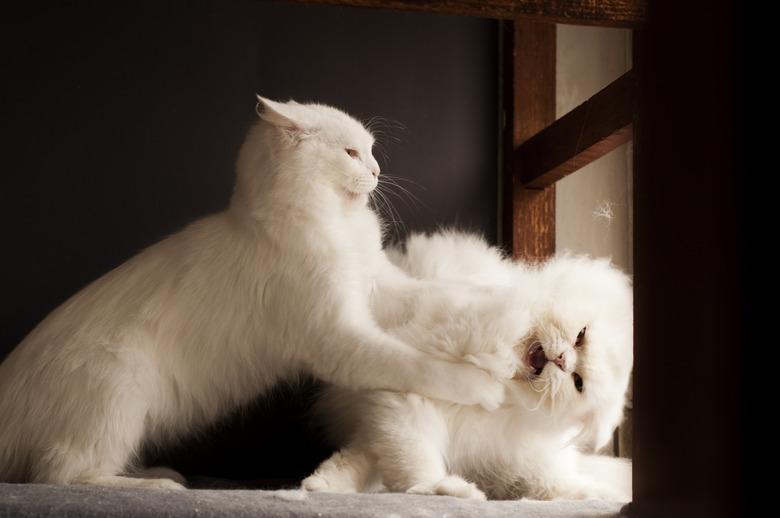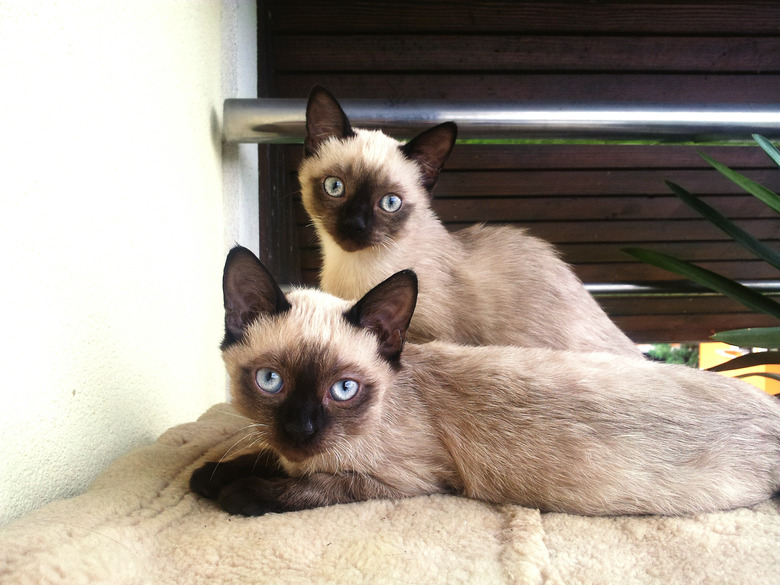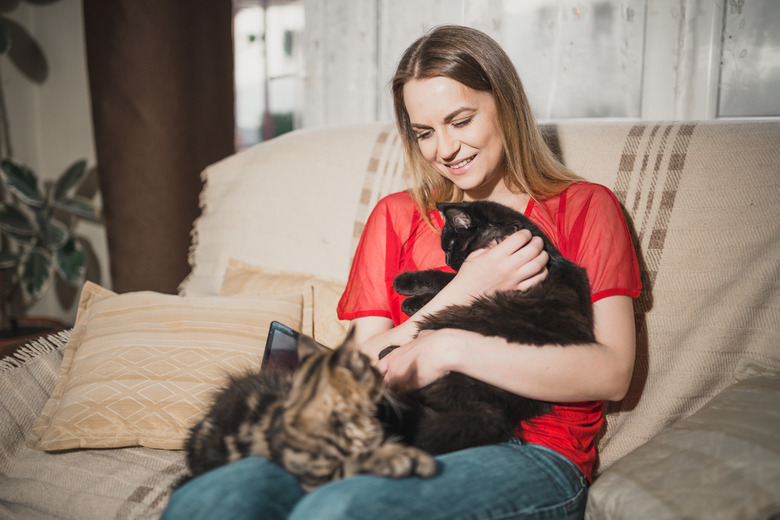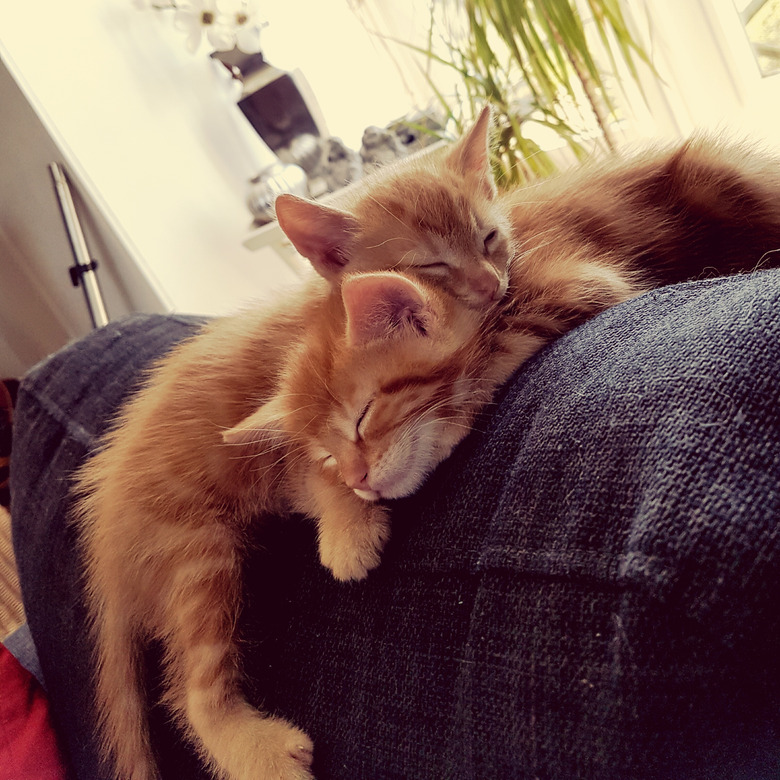How To Tell If Your Cats Like Each Other
Cats have a reputation for being solitary creatures. They're not always the most friendly—with people, with dogs, or even with each other. But even the most stoic and solitary of animals can form lasting friendships. Sometimes, two of those stoic, solitary animals can even befriend each other. Here's how to tell if your cats like each other.
How to tell if cats like each other
How to tell if cats like each other
First things first: How can you even tell if two cats like each other? Do they just...not act like they hate each other?
There are a few signs and they're the same ones that show us that cats like us. Cats who like each other will want to share their scent, which means lots of rubbing their heads and bodies together. They're also likely to engage in co-grooming, licking and kissing each other. Cats who are BFFs might also intertwine their tails and cuddle up next to each other in their sleep—this last one is huge because it's a sign that the cats trust each other and feel safe together. Finally, cats who are friends will play around and rough house without taking things to a truly aggressive place.
How can I tell if cats are fighting or playing?
How can I tell if cats are fighting or playing?
Okay, you might be thinking, but how can I tell if the cats are just best friend fighting or REAL fighting? Here's what you need to know about cat playing versus cat fighting.
First of all, know that playtime is vital for cats, especially kittens, who use it as an opportunity to develop skills and practice classic cat behaviors like stalking, chasing and pouncing. Playtime (which, again, might look to an outsider like fighting) is an important time for kittens to learn how to communicate with each other and what different kinds of body language means.
As cats get older, they'll often continue to play if they live with other kitties, and that play might look a little aggressive to humans, especially if the cats are really having a great time. However, it's important to keep in mind that this is usually going to take place between cats who know and like each other, not cats who have just met or seem at all iffy about one another.
If you're worried that your cats' play has crossed the line into aggressive fighting, look out for these signs that things are getting real (in a bad way):
- If the claws come out—literally.
- If the cats' ears are pinned back.
- If either cat's hair is standing on end.
- If the cats start growling.
- If the cats start hissing (cats are very vocal about their anger).
- If the cats start biting each other excessively or hard enough to cause pain or injury.
How to get cats to like each other
How to get cats to like each other
So you want to add another cat to your family and you want to make sure he or she gets along with the existing lord of the manor. Or maybe you've already introduced a second cat and it's not going...great. Here are some steps you can take to maximize the friendship potential between cats.
First, if at all possible, start planning your Parent Trap-esque friendship setup early. If you already have a playful cat, get another playful cat. If your cat likes to laze about all day, get another lazy cat. Making sure your new cat's temperament matches that of the established cat is one of the best ways to promote a friendship.
Also, take things slowly—don't jump right in with "now you're roommates! Be besties!" Let the cats meet a few times before the big move to give them time to warm up to each other slowly, and to make sure the existing cat doesn't feel as though it's being replaced.
If you already have two cats living together who aren't the best of buds, you can still do things to encourage a friendship between them. First, make sure that each cat has his own food bowl, water bowl, and litter box, and place their respective eating/drinking/bathroom-ing items at least six feet apart. This will make the cats feel like they have some personal space of their own. Just like humans, cats appreciate having a little place to call their own, and to escape when they need to.
Another way to foster a friendship between the cats is to get involved. It will take time and attention on your part, but try to dedicate an hour a day to actively playing with the cats. They presumably both like you (hopefully, anyway) so you can be the cool mutual friend who bridges the gap.
Finally, if all else fails, you can try pheromones. Cats naturally produce pheromones, so you can rub a towel on each cat's cheek and expose them to each other's scents while they're safely separated. This can help them get to know each other. You can also try a synthetic pheromone spray or diffuser, which can be bought in your local pet store or, of course, online.
How to manage things if the cats refuse to like each other
How to manage things if the cats refuse to like each other
Not all friendships are meant to be, of course. If your cats just don't seem destined to be the best of buds, there are some steps you can take to manage their aggression, according to the ASPCA, including:
- Don't just let them fight their troubles out. It only makes things worse. They won't get anything out of their systems. Just...don't.
- Interrupt any aggressive episodes by clapping loudly or spraying the cats with a squirt from a spray bottle.
- If the cats are male (or either of them is) get them neutered, which will make them less aggressive in general.
- Make sure they each have their own food and water bowls and litter boxes and put them far away from each other. This gives the cats a feeling that they have their own space and helps avoid territorial fights.
- Buy more perches, scratching posts, etc. — having a lot of places for the cats to hang out separately can discourage fights.
- Reward the cats with food or praise when they're actually being civil with each other.
How to tell if cats are bonded
How to tell if cats are bonded
Cats can form very, very strong friendships that ascend to the next level: bonds. Just like other bonded animals, bonded cats are very insistent on being together and may exhibit signs of anxiety if they're separated. Typically, bonding occurs when cats are very young, during the sensitive development period they experience between the ages of two and seven weeks.
Often, if cats are bonded, even shelters will attempt to keep them together—it's that difficult for the cats to be separated.
"When making a decision about keeping a pair together, many factors are considered. We pay close attention to each animal's behavior alone and with his friend," Kentucky Humane Society Placement and Behavior Manager Brandi King explained. "If we see obvious signs of increasing stress and anxiety upon separation that doesn't diminish as the animals settle in at the shelter, we will consider adopting them as a pair. We take their history into consideration, particularly if the previous owner has noted signs of distress when the animals were separated. It can be a bit of a process, but it's worth it in the end to ensure the well-being of bonded pairs.



